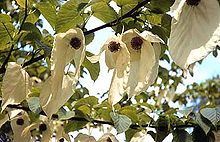Cornales: Difference between revisions
m Bot: Migrating langlinks to WP:Wikidata - d:q21769 |
no italics for families |
||
| Line 6: | Line 6: | ||
| subdivision_ranks = Families |
| subdivision_ranks = Families |
||
| subdivision = |
| subdivision = |
||
* |
*[[Cornaceae]] |
||
* |
*[[Curtisiaceae]] |
||
* |
*[[Grubbiaceae]] |
||
* |
*[[Hydrangeaceae]] |
||
* |
*[[Hydrostachyaceae]] |
||
* |
*[[Loasaceae]] |
||
}} |
}} |
||
'''Cornales''' is an order of [[flowering plant]]s, basal among the [[asterids]], containing about 600 species. Plants within Cornales usually have four-parted flowers, [[drupe|drupaceous]] fruits, and inferior [[gynoecium|gynoecia]] topped with disc-shaped [[nectar]]ies. Under the [[Angiosperm Phylogeny Group|APG]] system, Cornales includes the following families: |
'''Cornales''' is an order of [[flowering plant]]s, basal among the [[asterids]], containing about 600 species. Plants within Cornales usually have four-parted flowers, [[drupe|drupaceous]] fruits, and inferior [[gynoecium|gynoecia]] topped with disc-shaped [[nectar]]ies. Under the [[Angiosperm Phylogeny Group|APG]] system, Cornales includes the following families: |
||
Revision as of 11:09, 16 June 2013
| Cornales | |
|---|---|

| |
| Dove tree in flower a species in Nyssaceae | |
| Scientific classification | |
| Kingdom: | Plantae |
| Clade: | Tracheophytes |
| Clade: | Angiosperms |
| Clade: | Eudicots |
| Clade: | Asterids |
| Order: | Cornales |
| Families | |
Cornales is an order of flowering plants, basal among the asterids, containing about 600 species. Plants within Cornales usually have four-parted flowers, drupaceous fruits, and inferior gynoecia topped with disc-shaped nectaries. Under the APG system, Cornales includes the following families:
- Cornaceae (the dogwood family, including Nyssaceae, the tupelos)
- Curtisiaceae (cape lancewood)
- Grubbiaceae (the sillyberry family)
- Hydrangeaceae (the hydrangea family)
- Hydrostachyaceae
- Loasaceae (the stickleaf family)
Phylogeny
Cornales is sister to the remainder of the large and diverse asterid clade.
Members of Cornales are highly geographically disjunct and morphologically diverse, which has led to considerable confusion regarding the proper circumscription of the groups within the order and the relationships between them.[1] Under the Cronquist system the order comprised the families Cornaceae, Nyssaceae, Garryaceae, and Alangiaceae, and was placed among the Rosidae, but this interpretation is no longer followed. Many families and genera previously associated with Cornales have been removed, including Garryaceae, Griselinia, Corokia, and Kaliphora, among others.[1]
Molecular data suggest that there are four clades within the Cornales: Cornus-Alangium, nyssoids-mastixioids, Hydrangeaceae-Loasaceae, and Grubbia-Curtisia, with Hydrostachyaceae in an uncertain position, possibly basal.[2] However, the relationship between these clades is unclear, and as a result of many historical taxonomic interpretations and differing opinions regarding the significance of morphological variations, rankings of taxa within the order are inconsistent.[1][2][3] These difficulties in interpreting the systematics of Cornales may represent an early and rapid diversification of the groups within the order.[2]
References
- ^ a b c Xiang, Q. Y., Soltis, D. E., Morgan, D. R., and Soltis, P. S. (1993). Phylogenetic relationships of Cornus L sensu lato and putative relatives inferred from rbcL sequence data. Annals of the Missouri Botanical Garden 80, 723-734.
- ^ a b c Fan, C. Z., and Xiang, Q. Y. (2003). Phylogenetic analyses of Cornales based on 26S rRNA and combined 26S rDNA-matK-rbcL sequence data. American Journal of Botany 90, 1357-1372.
- ^ Eyde, R. H. (1988). Comprehending Cornus - puzzles and progress in the systematics of the dogwoods. Botanical Review 54, 233-351.
